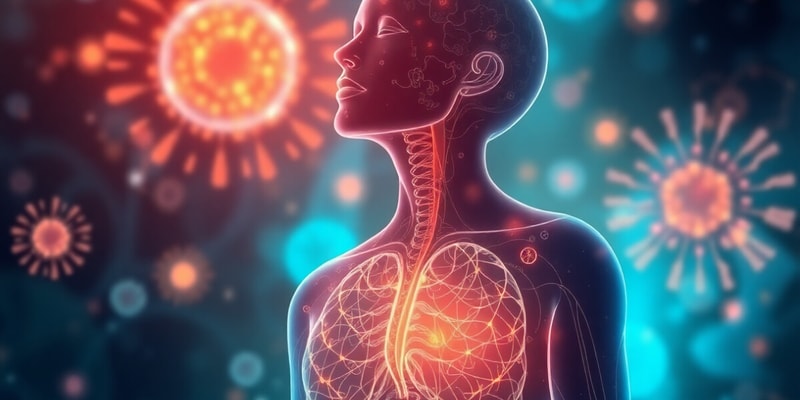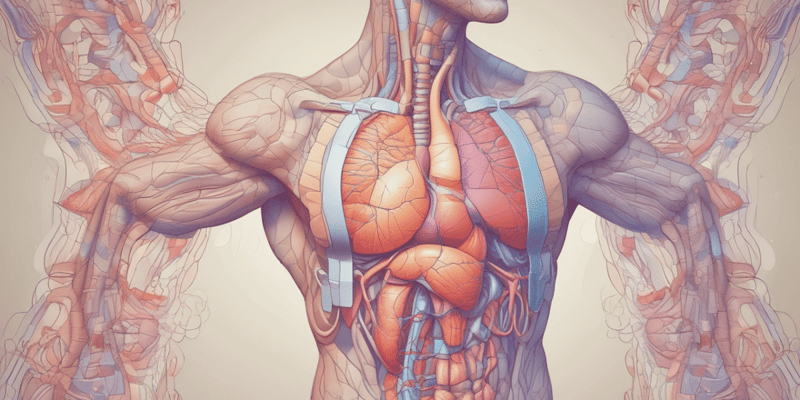Questions and Answers
What occurs when there is a lack of ATP in a cell?
Which test is most appropriate for assessing liver damage in a patient exhibiting symptoms such as jaundice?
What is the main cause of cellular degeneration leading to swelling?
What would indicate widespread damage to the liver?
Signup and view all the answers
Which symptom indicates that bilirubin is building up in the bloodstream due to cholestasis?
Signup and view all the answers
What is cellular necrosis?
Signup and view all the answers
When might a biopsy of the gland be required?
Signup and view all the answers
How does cellular swelling initially manifest?
Signup and view all the answers
What does the term 'aetiology' refer to in pathology?
Signup and view all the answers
What is meant by 'pathognomonic' lesions?
Signup and view all the answers
How does ambient temperature affect the rate of cooling of a body after death?
Signup and view all the answers
What is hypostatic congestion?
Signup and view all the answers
Why is it important to distinguish between post-mortem changes and lesions caused by disease?
Signup and view all the answers
Which of the following statements about rigor mortis is true?
Signup and view all the answers
What differentiates post-mortem clots from life clots?
Signup and view all the answers
What process refers to the breakdown of tissues after death?
Signup and view all the answers
What occurs during putrefaction?
Signup and view all the answers
What is a common color change associated with the autolysis of red blood cells?
Signup and view all the answers
How do higher temperatures affect enzyme activity during decomposition?
Signup and view all the answers
In what situation could decay obscure the manner of death?
Signup and view all the answers
Why do areas of the liver appear necrotic after death?
Signup and view all the answers
What factor can influence the staining of tissues post-mortem?
Signup and view all the answers
What is a potential source of enzymes during decomposition from ruminants?
Signup and view all the answers
When assessing decay for disease diagnosis, what is important to collect information on?
Signup and view all the answers
Study Notes
Iodine and Hormone Levels
- Iodine levels in the blood are critical for thyroid function.
- Low T4 levels suggest hypothyroidism; may indicate thyroid pathology.
- High TSH levels signal the body’s response to low thyroid hormones, often a sign of pituitary feedback.
- Biopsies can provide insight into epithelial cell numbers in thyroid glands.
Cellular Responses and Degeneration
- Cellular degeneration indicates reversible damage; necrosis signifies irreversible cell death.
- Lack of ATP disrupts Na+ pump functions, leading to cellular swelling due to osmotic imbalance.
- Initial signs of cell damage include swelling and breakdown of organelle functions.
Hepatic Dysfunction
- Bilirubin is normally processed by hepatocytes; hypoxia leads to hepatocyte swelling.
- Hepatomegaly can occur due to widespread liver damage, causing systemic symptoms like jaundice.
- Jaundice results from bilirubin accumulation in tissues, easily observed in the sclera (whites of eyes).
Disease Process Understanding
- Lesions can be gross (visible to the naked eye) or histological (visible under a microscope).
- Pathognomonic lesions uniquely identify specific diseases, but such cases are rare.
- Aetiology refers to the cause of a disease; pathogenesis encompasses the progression from cause to effect.
Post-Mortem Changes
- Bodies cool post-mortem, with cooling rates affected by environmental conditions and initial body temperature.
- Dead animals can produce ATP from remaining glycogen for a limited time after death; the rate of rigor mortis varies with temperature.
- Hypostatic congestion may indicate body position at death due to gravity's effect on blood pooling.
Tissue Decomposition
- Decomposition occurs via autolysis (cellular breakdown from enzymes) and putrefaction (bacterial breakdown).
- Enzyme activity increases in higher temperatures, leading to accelerated decay.
- Post-mortem color changes in organs provide clues about death circumstances but can complicate diagnosis due to decomposition.
Diagnostic and Pathogenesis Mapping
- Collect data spanning all stages of pathogenesis to develop an accurate disease diagnosis.
- Visualization methods (diagrams, mind maps) can enhance understanding of disease mechanisms and aetiology correlation.
Studying That Suits You
Use AI to generate personalized quizzes and flashcards to suit your learning preferences.
Related Documents
Description
This quiz explores essential concepts in endocrinology, focusing on iodine's impact on hormone levels and thyroid function. It also delves into cellular responses, degeneration, and hepatic dysfunction, highlighting the physiological implications of these conditions. Test your understanding of key terminologies and processes related to these crucial biological topics.




